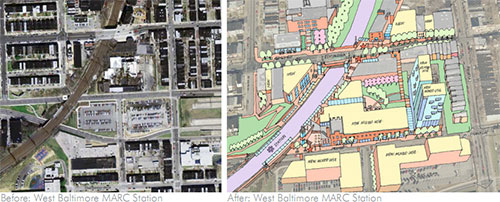Bye bye blank wall, hello parking lot, for now
A Baltimore Red Line news release touts the exciting news that Maryland will use stimulus money to demolish a portion of West Baltimore’s neighborhood-dividing “Highway to Nowhere”. In its place, leaders hope, will one day rise mixed-use development on this key transit node. In the meantime, though, the area will only get more parking.
The freeway is a 1.5-mile-long segment originally meant to carry I-70 I-170 through the city. Activists and leaders saved most of Baltimore from that project, but this piece replaced numerous city blocks with an open trench flanked by blank walls. Baltimore is taking down only an abandoned segment, two blocks long at one end of the freeway and next to the West Baltimore MARC.
The press release touts the “leadership of [Governor O’Malley] and the Maryland Transit Administration” to remove these walls that “block out the communities behind” and will “make it possible for transit-oriented development… to take shape on the lots.” Sounds exciting.
The real vision will have to wait until 2013 or later, however. Right now, all Maryland is doing is replacing the abandoned freeway with more surface parking lots. In place of an abandoned freeway that draws traffic without serving the surrounding communities, Baltimore gets 400 more parking spaces that will draw traffic without serving the surrounding communities.
Where the press release does mention transit-oriented development, it quickly adds that any such development will contain parking garages, perhaps to reassure Baltimoreans who can’t imagine any development, even next to transit stations, that isn’t mostly parking. The press release expresses enthusiasm for the long-term vision, but until one reads the full plan, it’s hard to tell whether leaders are more excited about the mixed-use potential or just the promise of more parking garages. Baltimore should dream a little bigger than that.
Still, this is a step. Maryland can use stimulus money to perform the necessary engineering to remove the freeway. The ultimate redevelopment is surely not “shovel ready.” It’s just too bad the best or only feasible interim use for the land is more car storage. If economic conditions inhibit the planned redevelopment, Baltimore will have only exchanged one auto-dependent use for another. Its leaders must ensure that does not happen.
Tip: Ben.

